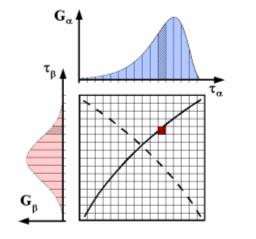


Heterogeneity and correlation of relaxation processesThe widespread assumption that primary and secondary relaxations in glass-forming materials are independent processes is scrutinized using spin-lattice relaxation weighted stimulated-echo spectroscopy. This nuclear magnetic resonance (NMR) technique is simultaneously sensitive to the dynamics on well-separated time scales. For the deeply supercooled liquid sorbitol, which exhibits a strong secondary relaxation, the observable primary relaxation can be modified by suppressing the contributions of those subensembles which are characterized by relatively slow secondary relaxations. Our experiments provide clear evidence for a correlation between primary and secondary relaxation times. In the disordered crystal ortho-carborane high-frequency processes are absent and consequently no such modifications could be achieved. |
 |